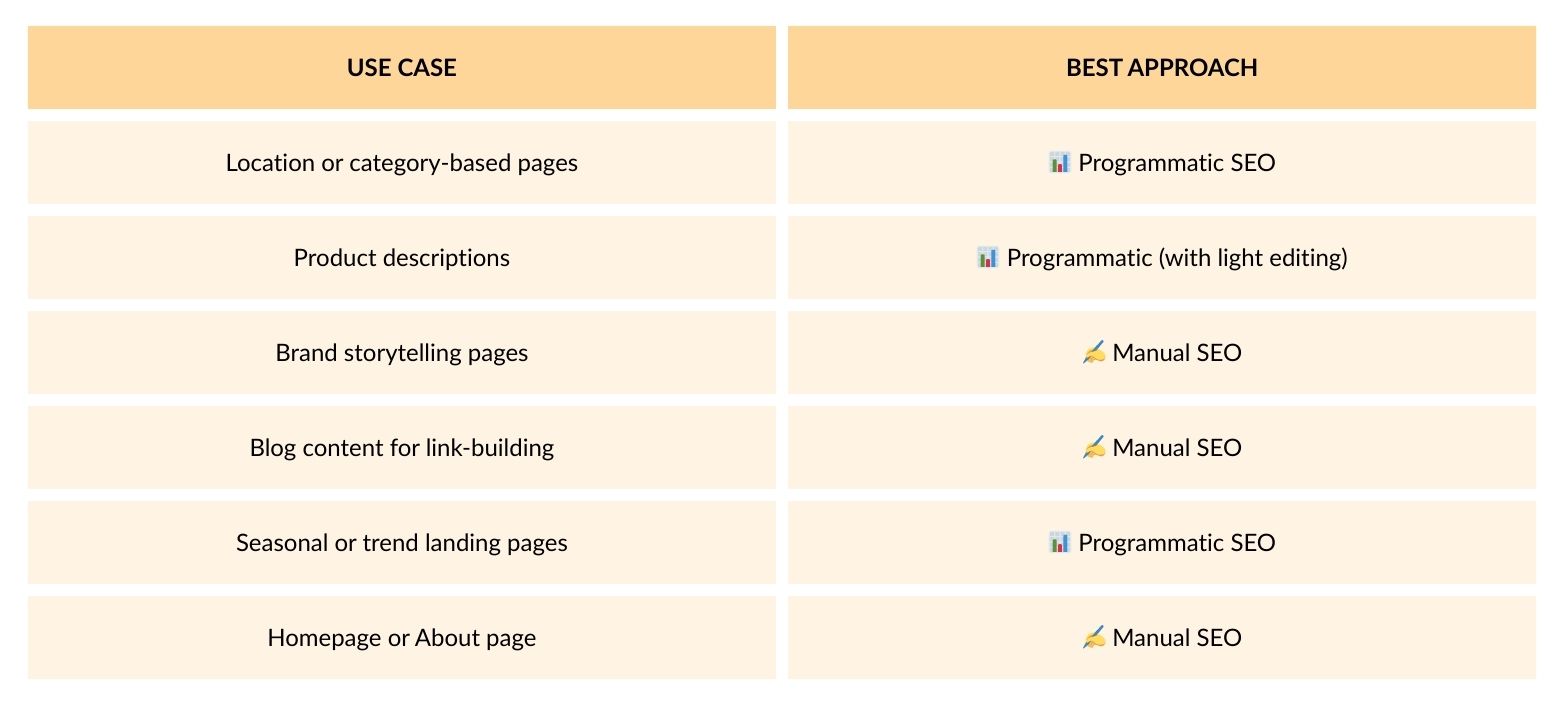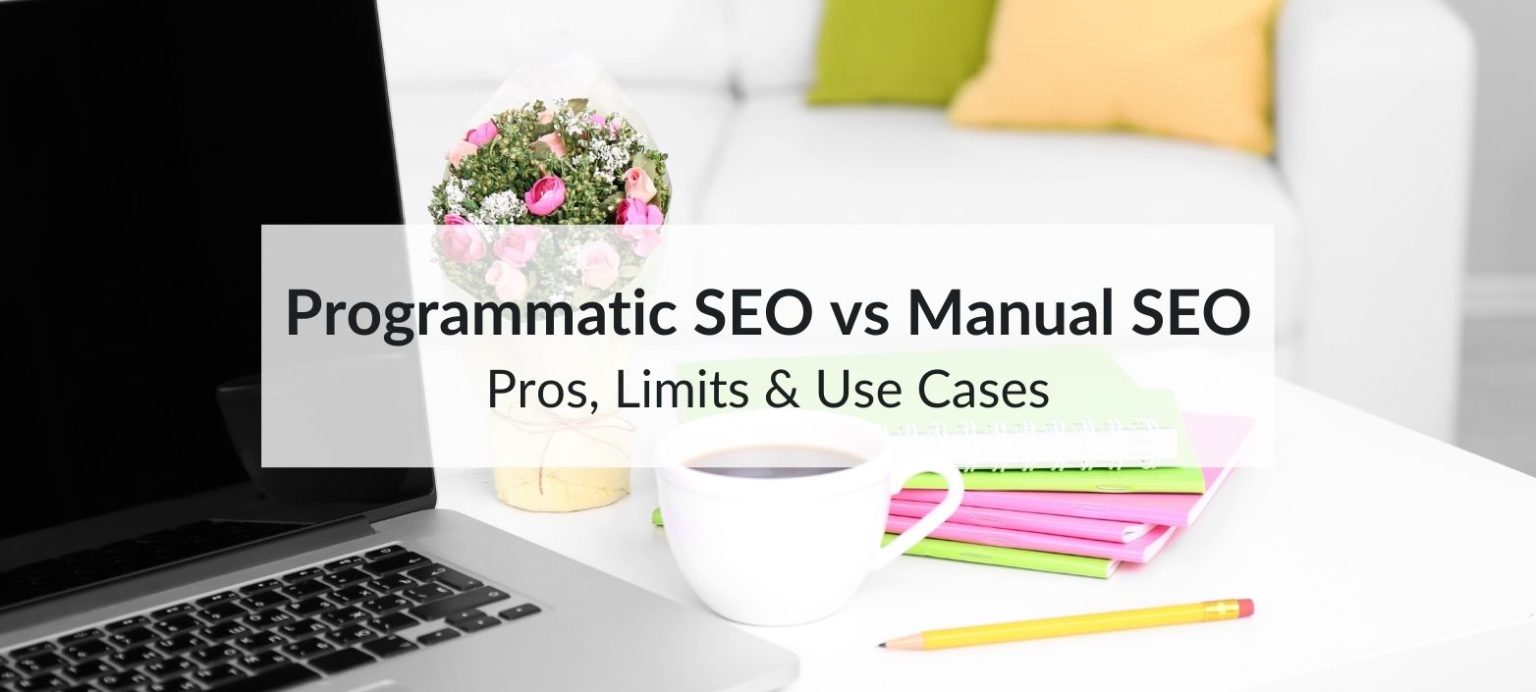Handling SEO for a big e-commerce site can be really challenging because there are so many pages to manage. Writing content by hand for every single page takes a lot of time, and as your store grows, it becomes harder to manage. That’s where programmatic SEO can help. It lets you create search-friendly pages automatically using structured data and smart tools.
But programmatic SEO isn’t always the right choice for everything. In some cases, like when you need more detail, a specific tone of voice, or strong brand messaging, manual SEO still works better.
So how do you know when to automate and when to write by hand?
In this guide, we’ll break down the key differences between programmatic SEO and manual SEO, explore real-world use cases, and show you how to apply the right approach for maximum search visibility and growth.
Table of Contents
Programmatic SEO vs Manual SEO: A Quick Breakdown
At its core, programmatic SEO means using automation tools like code, templates, and structured data to create a large number of SEO-friendly pages. It is especially useful for targeting keyword variations, location-based pages, or long-tail search terms.
Manual SEO, on the other hand, takes a more traditional route. Each page or blog post is written from scratch with careful attention to SEO best practices.
📊 Programmatic SEO: Powering SEO at Scale
Use Case:
Imagine you run an online furniture store. You want to rank for terms like “sofas in London,” “sofas in Birmingham,” and hundreds of other location-based keywords. Writing unique pages for all 100+ cities? That’s a nightmare, unless you automate it.
How it works:
- You create a template: [H1], description, specs, CTAs, all formatted with SEO in mind.
- Plug in structured data (like location, product name, pricing).
- A script auto-generates SEO pages based on your dataset.
✅ Pros of Programmatic SEO
- Scalability: Publish thousands of pages without manually writing each one.
- Consistency: Templates ensure your on-page SEO stays uniform.
- Data-rich targeting: Ideal for e-commerce filters like brand, size, color, etc.
- Speed: Fast time-to-market for new campaigns, especially useful for seasonal or trend-based traffic.
🚫 Limits of Programmatic SEO
- Thin content risk: If templates lack depth or uniqueness, Google might devalue or ignore your pages.
- Requires dev resources: You’ll need a team (or tools) to build and maintain templates and data pipelines.
- Not ideal for storytelling or high-conversion content like homepage copy, pillar blogs, or brand messaging.
✍️ Manual SEO: When the Human Touch Wins
Use Case:
You’re launching a new line of “eco-friendly clothing.” You want the product landing page to reflect your brand’s values, include hand-picked keywords, and emotionally connect with your audience. That level of depth? It needs a human.
✅ Pros of Manual SEO
- Creative flexibility: Customize tone, storytelling, and user experience.
- Depth & relevance: Perfect for complex or competitive keywords where authority matters.
- Brand voice: Manual writing nails your tone and builds trust.
- Backlink-worthy: Great manual content attracts links and shares.
🚫 Limits of Manual SEO
- Time-consuming: You can only produce so much content manually.
- Resource-heavy: Costs increase when scaling beyond a few dozen pages.
- Inconsistent structure: Without templates, content style and formatting can vary widely.
How to Choose the Right Approach (or Mix Both)

The smartest strategy is not to choose one over the other, but to combine both based on your specific goals and resources.
Tools & Strategies to Make Programmatic SEO Work
Programmatic SEO is useful because it helps create many pages, but it needs careful planning instead of just making pages quickly and hoping they work. To actually drive traffic and avoid getting removed from search results, you need the right tools, smart data planning, and a bit of human input. Here’s how to make it work the right way:
⚙️ Tool #1: Airtable + Webflow (or Your CMS of Choice)
Airtable is a spreadsheet-meets-database tool that’s perfect for managing large content datasets. Think of it as the engine behind your programmatic SEO efforts. You’ll use it to organize:
- City or location names
- Product categories
- Pricing tiers
- Delivery options
- Unique data points (like reviews, awards, or testimonials)
From there, tools like Webflow, WordPress + Custom Fields, or Sanity CMS can pull data into dynamic page templates. Each row in Airtable becomes a full page on your site with optimized titles, meta descriptions, and structured content.
Example:
If you sell custom mugs, you could programmatically generate landing pages for “Funny Mugs for Teachers,” “Funny Mugs for Dog Lovers,” “Funny Mugs for Bosses,” etc., using Airtable data + a content template.
Why it matters:
- You maintain full control over how the data is displayed
- It’s easier to scale and maintain consistency
- You can personalize at scale without writing from scratch
⚙️ Tool #2: ChatGPT + Prompt Engineering for Microcopy
AI can actually enhance your programmatic SEO strategy, if used responsibly.
Use ChatGPT or Claude to automatically create custom intros, FAQs, or call-to-actions for your templated pages. Instead of every page starting with “Welcome to our store,” aim for something more specific like “Looking for the best BBQ rubs in Brighton?” or “Need budget car hire in Leeds?”
Here’s how to do it:
- Create prompts based on variables (e.g., location, product category, tone)
- Batch generate microcopy variations
- Plug that copy into your CMS as part of your templated structure
This adds a much-needed human layer to your automated content, making it more appealing to users and to Google’s crawlers.
🔍 Tip #1: Start With High-Intent Long-Tail Keywords
Programmatic SEO is most effective when focused on low-competition, long-tail keywords that people are genuinely searching for. Instead of trying to rank for a broad term like “TVs,” target something more specific like “32 inch smart TV with built-in Alexa under £300.”
Use tools like:
- Ahrefs: For SERP analysis and traffic estimates
- SEMRush: For keyword difficulty scoring
- LowFruits.io: For quick wins with weak competition
- Google Search Console: To find keyword variations your site already ranks for
Pro Tip:
Do more than just collecting keywords. Make sure they align with what the user is actually trying to find. Let that understanding guide how you write your template content.
🔍 Tip #2: Use Structured Data to Your Advantage
Want to boost your CTR and get rich snippets? Use schema markup on your programmatically generated pages.
Add schema for:
- Product (with pricing and availability)
- FAQ (with auto-generated FAQs using AI or customer queries)
- Breadcrumbs (for easier navigation and indexation)
- LocalBusiness (if targeting geo-specific queries)
Structured data improves visibility and helps Google understand your content even when it is created using templates.
Common Mistakes to Avoid in Programmatic SEO
Many businesses rush into programmatic SEO hoping for instant traffic, but they end up with bloated websites, poor rankings, and wasted time. Avoid these common pitfalls to make sure your strategy scales smart.
❌ Mistake #1: Generating Too Many Pages Without Demand
Just because you can create 10,000 pages doesn’t mean you should.
Many site owners create hundreds of “Category + City” pages without checking if people are actually searching for those combinations. Result? Zero traffic, wasted crawl budget, and possibly a manual penalty if Google views it as spammy.
Fix it:
Do proper keyword research before creating page templates. Look at actual search volume, intent, and competition. Use keyword clustering to identify themes that matter.
❌ Mistake #2: Using Identical Copy With Just One Variable Changed
This is the cardinal sin of programmatic SEO: creating cookie-cutter content with only one word swapped out. (e.g., “Buy dog beds in Manchester,” “Buy dog beds in Liverpool,” etc.).
This type of content adds no unique value and could be flagged as duplicate or thin content by Google.
Fix it:
Inject dynamic content:
- Pull in real customer reviews
- Show city-specific inventory or shipping options
- Use AI to create varied intros
- Highlight unique USPs per location or variant
Even a few tweaks per page can help them pass the quality threshold.
❌ Mistake #3: Forgetting About Internal Linking
One of the most overlooked parts of programmatic SEO is internal linking. If you generate 500 pages but don’t link to them from existing content or your sitemap, they won’t get crawled or indexed quickly.
Fix it:
- Include “related pages” sections in your templates
- Update your category pages to link to long-tail variants
- Use breadcrumb navigation and HTML sitemaps
- Submit updated XML sitemaps to Google Search Console
Link equity is key. Make sure your automated pages are woven into your site’s structure.
❌ Mistake #4: Ignoring Page Speed & Technical SEO
Programmatic SEO often means building many media-rich, dynamic pages. But too many of these can slow your site down. When pages take too long to load, users leave quickly and rankings drop.
Fix it:
- Optimize your images and compress dynamic content
- Use lazy loading and caching (especially with CMS like WordPress or Webflow)
- Minify your template CSS/JS
- Use tools like PageSpeed Insights, Lighthouse, or GTmetrix to test performance regularly
Fast, responsive pages win, especially when you’re publishing them at scale.
Final Thoughts
If your e-commerce store has a large product catalog, multiple locations, or numerous filters, having the right SEO strategy is important. Programmatic SEO can be a powerful solution, but don’t overlook manual SEO, as it still plays an essential role in building your brand, creating content that converts, and showcasing your expertise.
The key is to know when to use each. Use programmatic SEO to handle large amounts of content, and use manual SEO to focus on quality and value.

